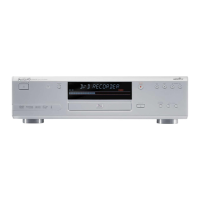during recording. The dye based RW recordable
layer provides a reflectivity of 40% light return
and 70% light return. 40 percent reflectivity rep-
resents Pits and the 70% represent the Lands.
Record Process
The record process shares most of its mechani-
cal operation with that of the play process. The
main difference is how the Servo is locked to the
disc. The Servo follows the Pre-groove for Radial
Tracking and disc speed. The speed of the disc
is locked to a wobble signal that is part of the
spiral grove stamped into the disc.
The intensity of the laser beam is modulated
from playback intensity to write intensity. As the
disc reads the Pre-groove, the laser arrives at a
position where a Pit is to be formed. The laser
power increases from 4mW to 11mW. This raises
the temperature of the disc to 250 degrees
Celsius. The recordable layer melts, reducing its
volume. The polycarbonate flows into the space
vacated by the dye. The modulation from read
laser power to write laser power forms a pit and
land pattern effectively the same as a prerecord-
ed disc.
Re-recordable Technology
Disc Mechanical Layout
Disc usage mechanically is identical to the
recordable media. The only difference is the
chemical make up of the recordable layer. The
recordable layer is made up of an alloy of silver,
indium, antimony and tellurium.
Re-Recording Process
The Re-Record process shares much of its oper-
ation with that of a CDR. The blank disc’s
Information Area is in a polycrystalline state.
During recording, the laser power is modulated
from 8mW to 14mW. 8mW is the playback laser
power and 14mW is the record laser power. The
polycrystalline state of the recordable surface
changes, or melts at 500-700 degrees C into an
amorphous state. The melted, amorphous areas
reflect light less than the crystalline areas, creat-
ing a pattern similar to the stamped CD. A major
difference of CDRWs from CDRs is the ability to
erase.
The Erase Process
To Erase a CDRW disc, the recordable layer
must be returned to its polycrystalline state. This
is done by heating up the temperature of the
recorded surface to 200 degrees C. This is less
than the melting point. This is done at X2 record-
ing speed. The slower speed allows time for the
alloy to return to its proper state. This takes
approximately 37 min. Some software erases the
just the TOC on the disc and allows the disc to
be rewritten. This method is not as reliable
Over Writing Process
Overwriting combines the processes of erasing
and writing. When the disc and Light Pen are in
position to start writing the new data, the laser
power starts modulating in the same manner as
it does for normal recording with one difference.
During the time there is to be a land, the laser
power goes to the erase level rather than the
playback level.
Figure 8 – Mechanical Layout of a DVD
5

